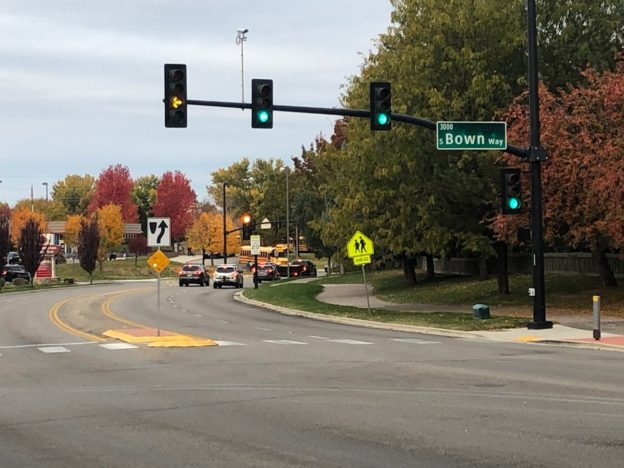By Don Kostelec
November 8, 2019
While vulnerable road users get the bulk of attention in Vision Zero discussions, it’s important we not forget that motorists are just as exposed to engineering practices that compromise their safety.
My thinking on this has evolved a lot in the last year. When a motorist injures or kills another road user, safety professionals and advocates serious about Vision Zero should recognize that the driver was also put in an unsafe and unfair situation. A Vision Zero approach recognizes the slightest lapse in judgment or error by any road user is compounded by road design practices that are either contributory to the crash or make the crash more severe.
I point to the widespread application of Flashing Yellow Arrow (FYAs) traffic signals as influencing my evolution.
The latest advancement in my thinking came when I recently helped a Boise-area attorney succeed in getting charges reduced for her client who was determined to have caused a crash while maneuvering through the FYA phase of a traffic signal.
Earlier this year I did media interviews about FYAs due to high profile crashes in the area, including the deaths of two pedestrians–Bob and Florence Goar.
This caught the attention of a local attorney, who out of a favor to a friend, agreed to represent the driver in a case where she was charged with misdemeanor reckless driving for a crash that occurred while making a turn during the FYA signal phase. The attorney does wills and estates work, not traffic work, so this isn’t her day-to-day thing.
The attorney’s goal was to get her client’s charge reduced to a citation rather than misdemeanor reckless driving. What caught her attention was the interview where I made a comment on how FYAs ask drivers to do a lot of multi-tasking behind the wheel, which puts them in an unfair situation given all the variables road users encounter.
The FYA in question is along a 45 mph state highway in the Boise area. It requires a motorist to turn across three lanes of a traffic. The signal was installed on a state highway by the Ada County Highway District (ACHD), which manages signal systems on the local and state highway system.
ACHD converted this signal to a FYA from a protected only left turn signal (motorists can proceed only on a green arrow) sometime after 2015.
What helped the attorney get the charges reduced was a combination of local and federal publications about FYAs.
ACHD published an white paper on their FYA applications for an Institute of Transportation Engineers (ITE) conference in 2015. In it, ACHD’s licensed professional engineers wrote the following of their crash analysis:
- “ACHD experienced an increase in crashes at locations converted from a protected only signal to protected/permissive phasing with a FYA. This increase is a tradeoff for increased signal efficiency that is highly valued by the constituents of Ada County.” (page 6 of this report)
(Read that last sentence again. Rarely do engineers go on the record stating that the convenience of motorists is more important than safety, but there it is in writing.)
I gave the attorney that paper, along with FHWA guidance on protected-permissive turns that recommends against using them in situations with 45 mph traffic and across 2 or more lanes.
I was prepared to be deposed or testify in this case, but this information was enough to convince the prosecuting attorney’s office to reduce the charges to a citation before it got to court. (The location is similar to the one shown in the video below, but I don’t want to disclose the location that is the subject of this case.)
FYAs ask drivers to calculate a lot of factors when attempting to make that turn–oncoming speeds, appropriate gaps in traffic, sight distance, their own vehicle’s acceleration abilities–and that’s before we even add the influence of pedestrians crossing at the same time.
In a small way, I think this weird legal “victory” continues to build the case that traffic engineering practices contribute to human error and cause crashes. Yet the crash report generated for this crash will be another one that goes into the batch of false claims that “94% of crashes are due to human error.”
Today, we have at least one prosecuting attorney’s office in Idaho who has seen the case made before them that traffic engineering can cause the lapses in human judgment that lead to crashes. It’s pretty simple: Had this signal remained a protected left turn treatment as it was in 2015, this crash would have never occurred.
Ideally, agencies like ITD and ACHD will take note and have these FYAs removed. Perhaps another attorney will file a more comprehensive lawsuit that looks at a pattern of crashes created due to a chain of events set off by FYAs. It would be better than what Florida DOT did when drivers complained about feeling unsafe at FYAs: They told drivers to do better.
It feels odd for me because I helped a driver get off for a mistake that led to a crash. But Vision Zero is about engineering transportation systems that make sure human error doesn’t cause crashes or make them more severe.
I know from what I’ve researched that these signals are engineered to put drivers in a situation where making a mistake becomes a lot easier. And a driver’s life is just as important as the life of someone using another mode.

